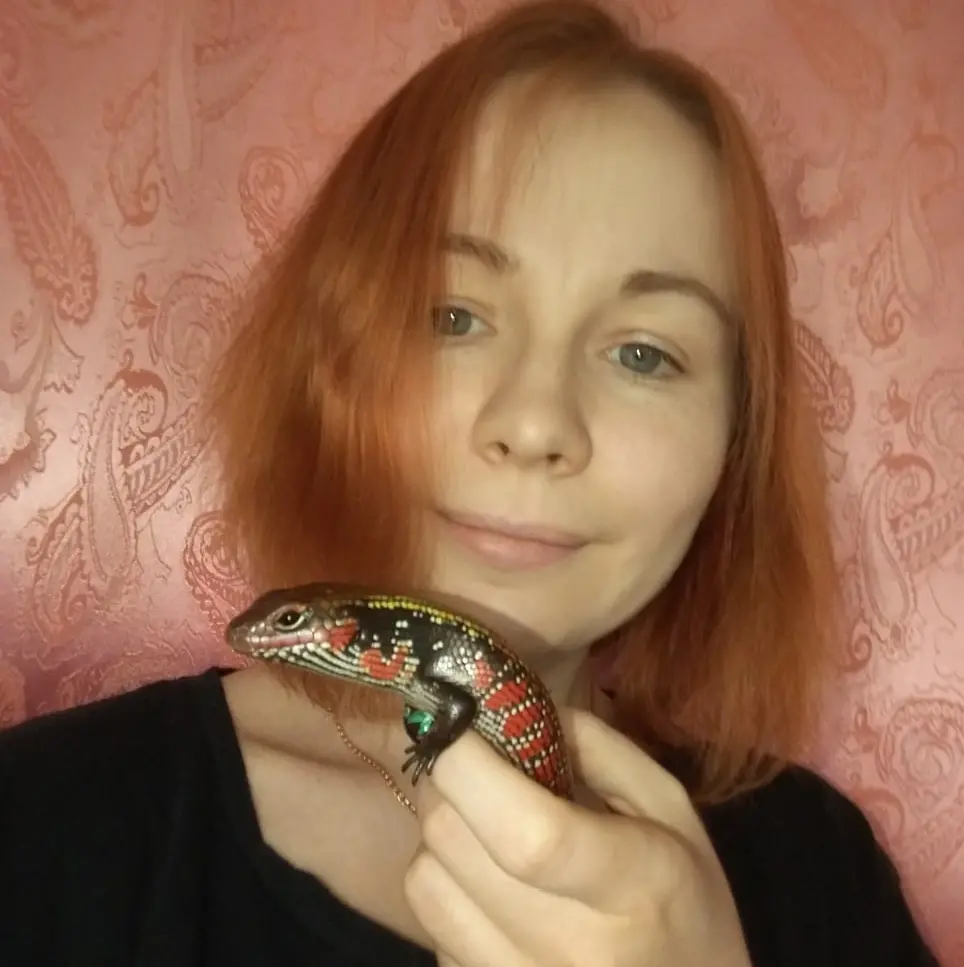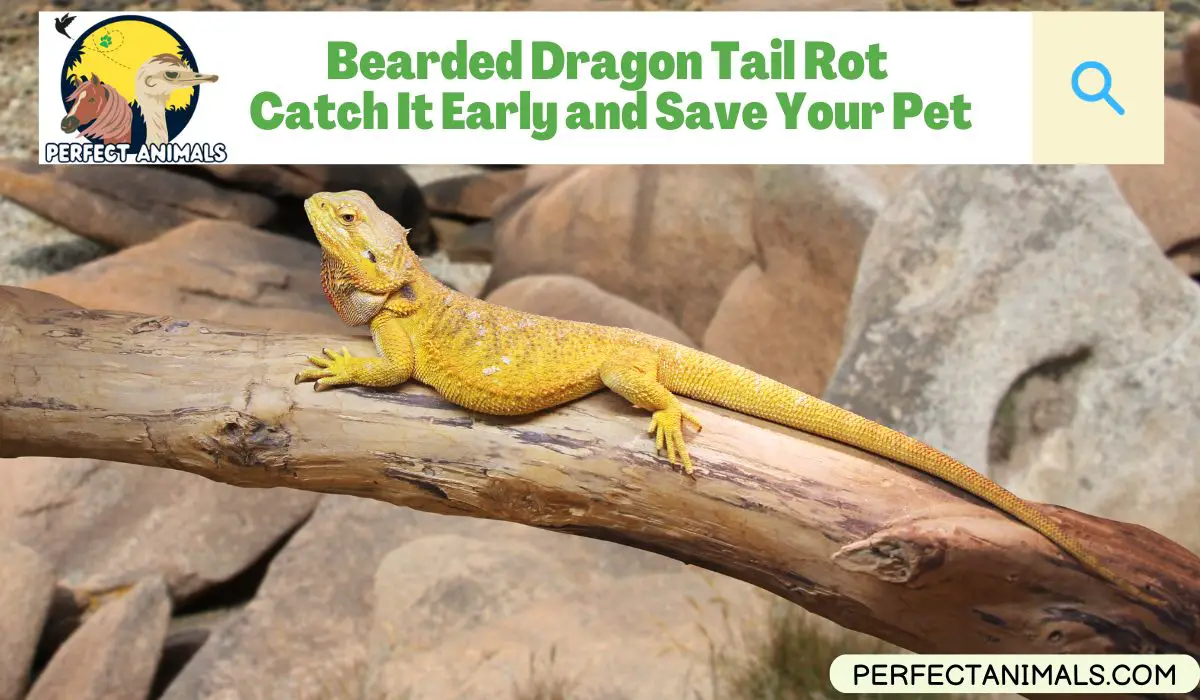Tail rot is one of the most common health issues affecting bearded dragons.
If you notice your friendly lizard’s tail looking abnormal, it could be this condition.
In this article, we’ll cover everything you need to know about bearded dragon tail rot – from causes and symptoms to treatment and prevention.
We want to help fellow beardie owners identify tail rot early and take the right steps to restore their pets to full health.
After all, we know how heartbreaking it is to see our scaly companions unwell.
So please keep reading to learn all about bearded dragon tail rot, what it looks like, and how to nurse your bearded dragon back to health.
What Does Tail Rot Look Like on a Bearded Dragon?
Tail rot can be tricky to spot at first, but being able to recognize the symptoms is crucial for getting your bearded dragon the right treatment.
Physical Changes
One of the clearest signs of tail rot in bearded dragons is visible physical changes to the tail and toes.
You’ll notice the infected areas gradually turn black, dry out, and become brittle over time due to lack of blood flow.
The tissue eventually dies off. There may also be no sensation left in portions of the tail as it gets worse.
These blackened, hardened areas indicate dying tissue and the infection can spread upwards from the tip of the tail to the rest of the body if not treated.
Tail Color Change
The beginning stages of tail rot can be seen through color changes to the tail, usually starting from the tip.
As tissue death (necrosis) starts to set in, the infected skin will turn shades like light gray, purple, black, or blue.
This discoloration is one of the earliest symptoms of the condition taking hold.
Dry, Flaky, Stiff Tail
Other physical indicators to look for are flaky, brittle, or coarse textures on the affected parts of the tail.
You may also notice a general stiffening or slight bending of the tail as the necrosis worsens.
These dry, rough patches develop as the tissue dies off from tail rot.
Pain
One critical sign is if your bearded dragon seems to be in pain.
They may flinch or squirm when their tail is touched.
This level of sensitivity likely indicates that tail rot has already developed, so pain is an important symptom to watch out for.
Now an important note: some bearded dragons naturally have darker tails. So a blackish tail alone doesn't necessarily mean tail rot unless you also see serious dryness, scaly skin layers, and brittleness. Look for multiple symptoms to be sure of the diagnosis.
Related Article – Scale Rot, Uncover the Deadly Truth
What Causes Bearded Dragon Tail Rot?
Tail rot is caused by an internal bacterial infection.
Gram-negative bacteria are often the culprits behind the condition.
These harmful bacteria enter a bearded dragon’s body, typically through a wound on the tail. They attack the tissue and spread, starting from the tail.
Trauma that injures the tail frequently enables these bacteria to infiltrate in the first place.
Common sources of injury include bites from other bearded dragons or insects, especially if housed together, and improper shedding that restricts blood flow.
The bacteria then infect the wound and quickly multiply.
Other factors can also set the stage for tail rot. An imbalanced diet lacking proper nutrition can make a bearded dragon more susceptible.
Insufficient UVB lighting is another possible contributor since it leads to vitamin D deficiency and compromised immunity. The bacteria take advantage of a weakened state.
In summary, tail rot usually starts with an injury to the tail, allowing bacteria to infiltrate and proliferate.
Poor diet and environment can also increase the risk.
But the root cause is gram-negative bacterial infection finding a way into the body through a compromised tail.
How To Treat Bearded Dragon Tail Rot
While tail rot requires veterinary treatment in severe cases, there are some at-home remedies that can be used for mild infections caught early on.
Though not a substitute for professional medical care, these remedies can potentially help halt progression in the early stages.
Try this multi-pronged approach.
Soak the Tail
One home remedy to try is soaking the infected part of the tail in a solution of one part white vinegar mixed with two parts warm water.
Do this for 5-10 minutes two or three times per day.
The vinegar solution helps kill bacteria and promote healing in the early stages of infection.
Apply Topical Medications
After soaking, gently dry the tail and apply an antibiotic cream like Neosporin or Betadine to the affected area.
Using a topical ointment prevents the spread of infection and aids healing. Apply it thinly after each soak.
Keep the Enclosure Clean
Maintain a clean, dry habitat to hinder infection growth.
Promptly remove any uneaten food or feces daily and disinfect the tank regularly.
Good hygiene limits bacteria spread.
Improve Diet and Lighting
Ensure your bearded dragon’s diet contains proper nutrition, and provide adequate UVB lighting.
A healthy diet and UV exposure support a strong immune system, which makes them more resilient against tail rot.
While these remedies may help mild cases, advanced tail rot requires veterinary care. But soaks, ointments and an improved habitat give mild infections a fighting chance.
Can a Bearded Dragon Regrow Its Tail?
No. bearded dragons cannot regenerate lost tails, unlike some lizards such as leopard geckos.
Leopard geckos can drop their tails as a defense mechanism when threatened, then regenerate the tail later.
Bearded dragons lack this ability and cannot spontaneously regrow a dropped or severed tail.

If a bearded dragon loses its tail due to injury, the tail will simply heal over where the loss occurred.
The tail does not grow back. While some owners report their beardie’s tail continues growing slowly throughout life, a completely detached tail will not regenerate.
If part of the tail is injured and becomes necrotic from something like tail rot, that damaged section may need surgical removal.
But the healthy part of the tail afterward will not regrow the amputated portion.
Proper wound care and veterinary attention are important following any significant tail injury.
So, what makes bearded dragons special is their wide array of defense tactics like puffing up and tail whipping – not tail regeneration.
Once injured, the tail will heal but not regrow if any section is fully detached.
Related Article – Bearded Dragon Shedding
How Much Does It Cost to Amputate a Bearded Dragon’s Tail?
The cost of surgically removing part of a bearded dragon’s tail can vary quite a bit based on several factors.
According to my research, basic tail amputation surgery can range from $150 to $300 on average.
However, costs could be higher depending on circumstances.
More complicated injuries or illnesses requiring tail amputation tend to raise the price.
If there is severe tissue damage from something like advanced tail rot, costs may be between $2000 to $3000 or more in some cases.
The specific surgical process needed also plays a role.
Geographic location and each vet’s pricing are other variables. Prices are often higher in major metro areas with a higher cost of living.
Specialist exotic vets also frequently charge more compared to general veterinary clinics.
In my experience as a bearded dragon owner, I found tail amputation surgery ranging around $250 from vets in my area, for less complex cases.
However severe injuries requiring delicate surgery can drive up the costs.
It’s best to be prepared for the higher end of the range if your beardie’s case is serious. Getting pricing estimates ahead of time is advised.
Related Article – Cuban False Chameleon
Final Thoughts
Tail rot can be scary for bearded dragon owners, but the key is catching it early and taking prompt action.
Check your dragon’s tail daily for any signs of discoloration, dryness, or deformation.
At the first hint of trouble, isolate your pet, boost hydration and nutrition, and call your exotic vet.
Though home remedies can sometimes turn around mild cases, advanced tail rot requires prescription medication and possible amputation.
With quick response, close monitoring, and proper treatment, most dragons fully recover from tail rot.
Be vigilant about hygiene and habitat conditions to reduce risk. And know when to seek medical advice sooner rather than later.
If treated rapidly, tail rot does not have to shorten your bearded dragon’s lifespan.
Catching the symptoms quickly is key. While tail rot is serious, it can be successfully managed with prompt veterinary care and some TLC at home during recovery.
With your bearded dragon’s fighting spirit and your attentive caregiving, you can beat this!
FAQs
How to identify a bearded dragon tail rot?
Look for physical signs like blackened, dry, brittle tail tissue, discoloration, flaky skin, and bending/drooping of the tail.
Also, watch for signs of pain like wincing when the tail is touched.
These symptoms indicate tissue death and infection.
Is bearded dragon tail rot contagious?
Yes, the bacteria that cause tail rot can be transmitted to other bearded dragons. It is important to quarantine an infected dragon and sterilize enclosures to prevent spread.
How to prevent bearded dragon tail rot?
Prevent tail rot by providing proper UVB lighting, a balanced diet, a clean habitat, avoiding overcrowding, and prompt treatment of any injuries to maintain good health and immunity. Carefully inspecting the tail can also catch early signs of infection.
Resources – (for further reading)
Vetericyn Animal Wellness – How to Treat Scale Rot on Reptiles
RSPCA – How To Care For Your Bearded Dragon
Arizona Exotic Animal Hospital – Atadenovirus in Bearded Dragons

Maya’s love for reptiles started in her teens with a pet snake. It grew into a collection of geckos, snakes, and more. She also cares for birds and cats, making a cozy home menagerie.


